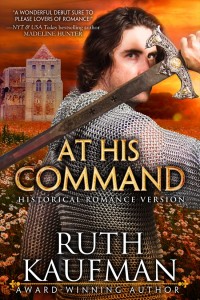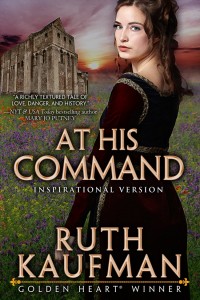Help me welcome Ruth Kaufman who has done a very unique thing with her soon-to-be-published book. Read on and find out what she’s done!

And the farther back you go, the fewer original materials exist. Scholars and historians are less certain or uncertain about what actually happened, say, at a certain battle. On one hand, I might need to know where King Henry VI was or what he was doing on a certain day and be frustrated when I can’t find out after checking several sources. On the other, when more than one resource says something like, “No one knows about X or Y,” I take that as a gift, an opportunity to fill in the blanks and create the information I need.
But how much history is too much? You want to include enough setting and detail so readers feel part of the environment, while not overdoing details and making it sound like Ruth the author wants to pour out every fact discovered during meticulous research. When an editor sent me a second revision letter for the Golden Heart® winning manuscript, AT HIS COMMAND, which I’m self-publishing next month, she wrote, “your commitment to historical accuracy is one of our favorite things about the manuscript…but at times the accurate depiction of court interferes with the romance.” The difficulty in making the requested changes was trying to guess which times she thought details interfered and which she liked. Of course, another editor or reader might have a different opinion, which could send an author spinning down a rabbit hole…

Incorporating a faith element, IMO, is similar to incorporating history. Not only does it require research and decisions on what to include when, the author must ask, “How much is too much?” You want to appeal to inspirational readers without preaching. Your hero and heroine should each have a faith journey that resolves in the end like the romance and conflict. But, as with history, those journeys shouldn’t overwhelm the romance.
I prefer historicals in which real history affects the characters and plot over romances simply set in a castle. Characters wear the right clothes and eat the right foods, but the plot could be moved to a different century with ease. So I weave actual historical figures and events into the story.
If writing historicals or inspirational historicals interests you, here a few suggestions to help you get started:
Choose your time period by assessing your interests. What events, notable people or places resonate with you? Are you drawn to art or fashion from a certain time? I chose mid-fifteenth century England because I was in a production of Richard III in college and wondered how much liberty Shakespeare had taken. The more I read about the actual RIII, the more I wanted to know. At the time, there were already romances involving him, so I chose a less familiar king.

Decide when to research and when to write. You may spend hours and hours immersed in research, but only new words on the page count. After I had a general understanding of events and notes on key details, I researched as I wrote. I’d leave this: // wherever I needed to fill in what they wore or ate, for example. That way I wouldn’t be pulled out of the writing zone, and could search later for // to fill in the blanks. On occasion, adding a new detail, such as, say, a sauced chicken dish, could heighten the scene I already had. Examples: if the sauce was too spicy and made her choke, the hero would then rush to her side. The dish reminded her of her deceased mother. I try to sprinkle details rather than have a whole paragraph(s) of description.
Assess the amount of each element: You could go through your draft and color code faith, history and romance to make sure the romance stands out. I actually searched my manuscript for the words faith, God and prayer to see how often I’d used them.
In the end, how much is too much in any book is up to the author first, then the readers.
***
What do you like to see in historicals and/or historical inspirationals as a reader and/or as an author?
Join us on Friday for another great post from Adrienne Giordano!
And stop in from December 24-31 and comment to win a free book in our Christmas Book giveaway!
***
Bio: Ruth Kaufman is a Chicago on-camera and voiceover talent and freelance writer, editor and speaker with a J.D. and a Master’s in Radio/TV.
Two versions of her medieval AT HIS COMMAND release January 14, 2015. One is inspirational and mild, the other has no faith element and opens the bedroom doors.
Writing accolades include Romance Writers of America® 2011 Golden Heart® winner and runner up in RT Book Reviews’ national American Title II contest. Her true, short story, “The Scrinch” is in St. Martin’s anthology The Spirit of Christmas, foreword by Debbie Macomber.
She’s appeared in indie features, short films, web series and national and local TV commercials, and has voiced hundreds of explainer videos, e-learning courses, commercials and assorted characters.